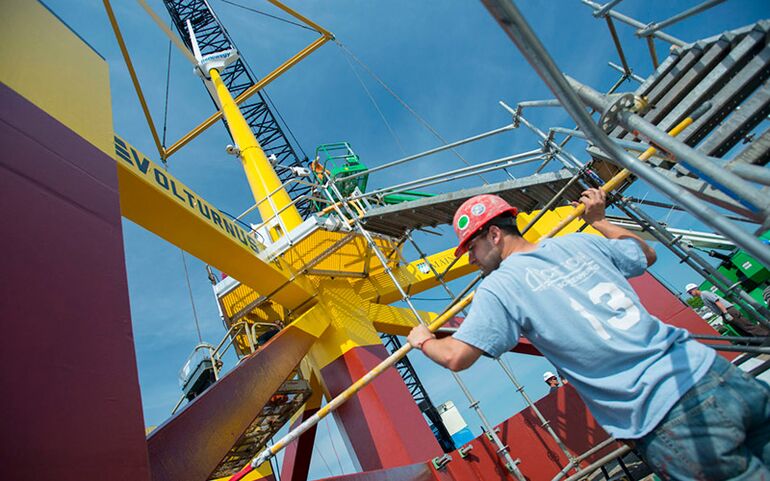Processing Your Payment
Please do not leave this page until complete. This can take a few moments.
- News
-
Editions
View Digital Editions
Biweekly Issues
- December 1, 2025
- Nov. 17, 2025
- November 03, 2025
- October 20, 2025
- October 6, 2025
- September 22, 2025
- + More
Special Editions
- Lists
- Viewpoints
-
Our Events
Event Info
Award Honorees
- Calendar
- Biz Marketplace
American Jobs Project: Offshore wind could support 2,100 Maine jobs annually
 Courtesy / Maine Aqua Ventus
A worker at Cianbro's Brewer facility checks on the prototype floating offshore wind platform that supported in 2014 the 1:8 scale VolturnUS wind turbine deployed off Castine in 2014. A report released today concludes that offshore wind is a “significant economic opportunity for job growth” that could support an annual average of more than 2,100 jobs through 2030.
Courtesy / Maine Aqua Ventus
A worker at Cianbro's Brewer facility checks on the prototype floating offshore wind platform that supported in 2014 the 1:8 scale VolturnUS wind turbine deployed off Castine in 2014. A report released today concludes that offshore wind is a “significant economic opportunity for job growth” that could support an annual average of more than 2,100 jobs through 2030.
Maine’s offshore wind potential and the expertise it’s already gained through the Maine Aqua Ventus project is a “significant economic opportunity for job growth” that could support an annual average of more than 2,100 jobs through 2030.
That’s the conclusion of “The Maine Jobs Project: A Guide to Creating Jobs in Offshore Wind,” a 57-page report released today by the American Jobs Project, a nonprofit based in Berkeley, Calif., that identifies economic opportunities for each of the 50 states based on its unique innovation ecosystem, access to capital, workforce development, value chain build-out and local market growth.
“There is a great offshore wind resource in Maine and the Northeast,” Mary Collins, co-author of the report and director of American Jobs Project, told Mainebiz in a telephone interview. “The U.S. offshore wind sector is about to take off, and Maine has an opportunity to shape this emerging industry.”
Collins said interviews with Maine stakeholders and analyses of leading economic indicators such as manufacturing capacity and resources availability led to the report’s conclusion that Maine is poised to be a leader in offshore wind innovation, manufacturing and deployment.
Here are some of the reasons:
- It already is home to R&D activities at the University of Maine’s Advanced Structures and Composites Center, which includes the world-class The Alfond W2 Ocean Engineering Lab is a 1:50-scale offshore model testing facility
- It has key legacy industries that are well-suited to take advantage of the accelerating offshore market, including shipbuilding, composites and the heavy industrial and marine capabilities of the Cianbro Corp., a leading business partner in the Aqua Ventus consortium that built the floating platform for the 1:8 scale VolturnUS pilot wind turbine deployed off Castine in 2014.
- Its expansive coastline, established deepwater ports and an offshore wind resource capacity of 156 gigawatts of potential energy (more than enough to meet Maine’s electricity needs that are estimated at 2.4GW of annual usage).
What’s needed to fully take advantage of those advantages and tap offshore wind’s full potential to create more than 2,000 good-paying jobs in Maine?
The Maine Jobs Project report offers 15 specific policy recommendation to capitalize on Maine’s offshore wind market potential, including enhancing the value chain, fostering innovation, improving access to capital and supporting workforce development. [For an in-depth look at those recommendations, click here or on the PDF link to the full report found at the bottom of this story]
Highlights of the report
Ryan Wallace, director of the Maine Center for Business and Economic Research at the University of Southern Maine, said recent awards by Massachusetts and Rhode Island, for industrial size offshore wind projects of 500 megawatts and 400 megawatts respectively, underscore two important points:
- Demand for offshore wind generation is rising around the world (particularly in Europe, which has a 20-year history in offshore wind and is moving toward projects in deeper waters that will require floating platforms).
- Maine has a tremendous opportunity to leverage the state's competitive advantages and be at the forefront of the offshore wind industry in the United States.
“Floating platforms is the next generation technology for offshore wind,” Wallace said. “That’s a competitive advantage the state has," he added, given the work that’s already been done to develop and prove that technology through the Maine Aqua Ventus project.
“The Maine Jobs Project demonstrates how our state can capitalize on this opportunity and offers a pathway for growth and collaboration across industry, government, and university partners,” said Wallace, who noted that Maine Center for Business and Economic Research was one of several Maine partners with the American Jobs Project on the report.
Among the highlights of the report:
- The offshore wind industry could support in Maine an average of 2,000 jobs each year through 2030. This figure includes direct jobs from manufacturing and software development, indirect jobs from suppliers, and induced jobs from spending in the local economy. Job opportunities include civil engineering (average hourly wage $37.65), electrical and electronics engineering technicians ($31.37), construction laborers ($14.93), welders and metalworkers ($22.30), environmental scientists ($29.13) and machinists ($22.10).
- Growth in demand for offshore wind energy is accelerating, with the industry projected to grow 16% annually through 2030.
- Maine is home to concrete production and manufacturing facilities and assets that can be used to locally construct wind turbine components, such as floating foundations.
- Maine could harness its natural resource potential to mobilize the offshore wind market in the Northeast by supplying expertise and products to facilitate an expected build out of 7.5 GW of offshore wind energy.
Strategies to tap the potential
Among key recommendations included in the 15 strategies spelled out in the report for Maine to fully capitalize on offshore wind’s job growth opportunities:
- Reestablish the Maine Planning Office to provide technical assistance, economic analyses, and coordinated resources in support of the state and municipal governments’ economic and energy planning needs.
- Bolster foreign direct investment to fill critical gaps in the value chain and make Maine a desirable option for offshore wind companies seeking to expand to the United States.
- Modernize Maine’s economic development strategies to attract and expand new businesses.
- Establish a Northeast Offshore Wind Innovation Center to coordinate regional offshore wind R&D efforts, foster engagement with important industry players across the North Atlantic, leverage investments from the federal government and state governments, and set and achieve goals related to floating foundation technology.
- Create an Offshore Wind Business Development Fund to assist emerging businesses in overcoming barriers to market entry, such as high administrative costs and capital expenditures needed to retool operations.
- Establish offshore wind certificate or degree programs to support a skilled workforce.
Next steps
Some credence is given to the report’s job growth estimates by recent New England news stories reporting on job prospects related to the Vineyard Wind project in Massachusetts and the Deepwater Wind project in Rhode Island.
The Lowell Sun reported that the full deployment of Massachusetts goal of 1,600MW of offshore wind (with Vineyard Wind providing approximately 800MW of that goal) would create up to 3,170 jobs in the next 10 years.
And the Providence Journal reported that Deepwater Wind’s 400MW offshore wind project will invest $250 million and use a local workforce of more than 800 workers.
Both Collins and Wallace said the Maine Public Utilities Commission’s pending decision on whether to reopen the power contract terms approved in 2014 for the Maine Aqua Ventus 12MW pilot project off Monhegan Island is a critical juncture —not only for that project but for the opportunity it offers to turn around a decades-long decline in manufacturing jobs in Maine.
If the PUC chooses to reverse course and negate the 2014 term sheet, both said it would send a strong negative signal to all the potential players, within and outside of Maine, that are poised to capitalize on the fast-developing offshore wind market emerging in the U.S.
“Businesses are looking for policy certainty when they consider making investments,” Wallace said. “They want to know what the lay of the land is. They want to know the rules are not going to change on them if they decide to proceed with their investment.”
DOWNLOAD PDFs
The Maine Jobs Project: A Guide To Creating Jobs in Offshore Wind
Read more
Maine offshore wind project back in the running for $40M award
French company partners with UMaine-led wind farm consortium
Fishermen express concerns about offshore wind turbines
PUC hits pause button on Maine Aqua Ventus' power contract
Aqua Ventus project eyes Boothbay cable connection
Maine Aqua Ventus awaits PUC decision as offshore wind takes off elsewhere
Maine Aqua Ventus awaits PUC decision as offshore wind takes off elsewhere
Mainebiz web partners
Related Content

The Giving Guide
The Giving Guide helps nonprofits have the opportunity to showcase and differentiate their organizations so that businesses better understand how they can contribute to a nonprofit’s mission and work.
Learn More
Work for ME
Work for ME is a workforce development tool to help Maine’s employers target Maine’s emerging workforce. Work for ME highlights each industry, its impact on Maine’s economy, the jobs available to entry-level workers, the training and education needed to get a career started.
Learn More
Groundbreaking Maine
Whether you’re a developer, financer, architect, or industry enthusiast, Groundbreaking Maine is crafted to be your go-to source for valuable insights in Maine’s real estate and construction community.
Learn more-
The Giving Guide
The Giving Guide helps nonprofits have the opportunity to showcase and differentiate their organizations so that businesses better understand how they can contribute to a nonprofit’s mission and work.
-
Work for ME
Work for ME is a workforce development tool to help Maine’s employers target Maine’s emerging workforce. Work for ME highlights each industry, its impact on Maine’s economy, the jobs available to entry-level workers, the training and education needed to get a career started.
-
Groundbreaking Maine
Whether you’re a developer, financer, architect, or industry enthusiast, Groundbreaking Maine is crafted to be your go-to source for valuable insights in Maine’s real estate and construction community.
ABOUT
NEW ENGLAND BUSINESS MEDIA SITES
No articles left
Get access now
In order to use this feature, we need some information from you. You can also login or register for a free account.
By clicking submit you are agreeing to our cookie usage and Privacy Policy
Already have an account? Login
Already have an account? Login
Want to create an account? Register
Get access now
In order to use this feature, we need some information from you. You can also login or register for a free account.
By clicking submit you are agreeing to our cookie usage and Privacy Policy
Already have an account? Login
Already have an account? Login
Want to create an account? Register











Comments